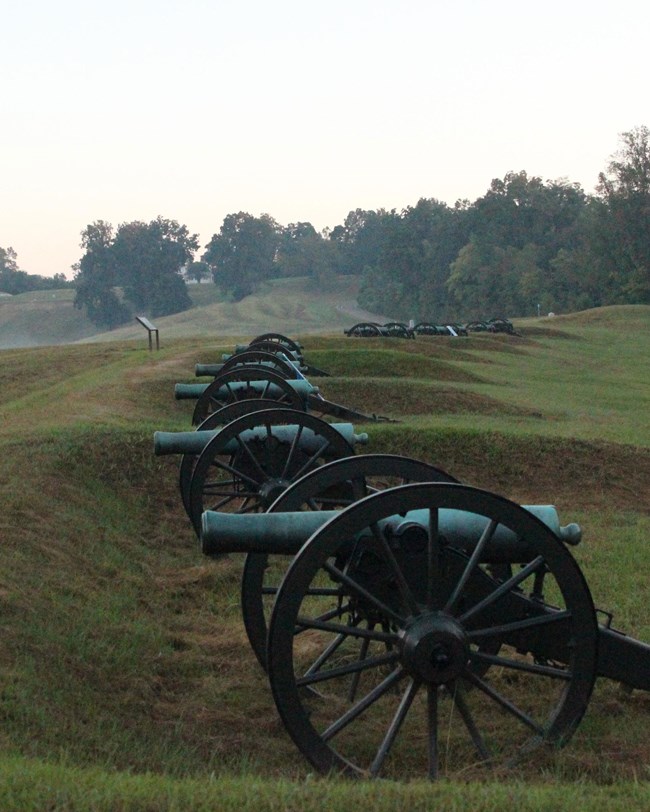Last updated: July 17, 2024
Article
NPS Geodiversity Atlas—Vicksburg National Military Park, Mississippi and Louisiana
Geodiversity refers to the full variety of natural geologic (rocks, minerals, sediments, fossils, landforms, and physical processes) and soil resources and processes that occur in the park. A product of the Geologic Resources Inventory, the NPS Geodiversity Atlas delivers information in support of education, Geoconservation, and integrated management of living (biotic) and non-living (abiotic) components of the ecosystem.

Introduction
Vicksburg National Military Park (VICK) is located along the Mississippi River in and around the city of Vicksburg in portions of Warren County, Mississippi and Madison Parish, Louisiana. Established on February 21, 1899, VICK contains approximately 729 hectares (1,802 acres) and commemorates the American Civil War campaign, siege, and defense of Vicksburg that resulted in a decisive Union victory and solidified Union control of the Mississippi River (National Park Service 2016a). During the spring of 1863, Union forces commanded by Major General Ulysses S. Grant launched a 47-day siege campaign to capture Vicksburg against defending Confederate forces commanded by Lieutenant General John C. Pemberton. As a valuable commercial port and railroad hub, Vicksburg represented a strategic military position of tremendous importance to the Confederacy. Grant’s strategy to lay siege to Vicksburg effectively cut off all supplies and communications from the rest of the Confederacy, slowly pressuring Confederate forces to seek terms of surrender. The landscape of VICK features reconstructed forts, trenches, earthworks, gun batteries, the Civil War ironclad gunboat USS Cairo, Vicksburg National Cemetery, and one of the most extensive collections of commemorative monuments, sculptures, and outdoor art on earth (National Park Service 2014c).
Geologic Setting
Situated near the boundary of the Mississippi Alluvial region and Gulf Coastal Plain region of the Coastal Plain physiographic province, the geology of Vicksburg National Military Park is comprised of Cenozoic-age bedrock that dates back to the Oligocene Epoch, approximately 34–23 million years ago. The geologic landscape of VICK is characterized by steep river bluffs, deep ravines, and flat-topped ridges that influenced the military history of the park and offered strategic defense positions. The oldest bedrock in VICK consists of sedimentary strata of the early Oligocene Vicksburg Group, which includes (from oldest to youngest) the Forest Hill Formation, Mint Spring Formation, Mariana Limestone, Glendon Limestone, Byram Formation, and Bucatunna Formation. Unconformably overlying the Vicksburg Group are locally indurated sandstones and clays of the late Oligocene Catahoula Formation and Pleistocene pre-loess terrace deposits largely composed of sand and gravel. Unconformably blanketing the pre-loess is a thick veneer of Pleistocene loess that forms the steep bluffs overlooking the Mississippi River. Loess is predominantly an eolian (wind-driven) deposit of fine silt that is derived from glacial outwash. The youngest units mapped within VICK consist of unconsolidated, surficial alluvium and abandoned channel-fill sediments of gravel, sand, silt, and clay that occur along the heavily dissected ravines and creeks within the park.
Regional Geology
Vicksburg National Military Park is a part of the Coastal Plain Physiographic Province in the Mississippi Alluvial Plain section and shares its geologic history and some characteristic geologic formations with a region that extends well beyond park boundaries.
- Scoping summaries are records of scoping meetings where NPS staff and local geologists determined the park’s geologic mapping plan and what content should be included in the report.
- Digital geologic maps include files for viewing in GIS software, a guide to using the data, and a document with ancillary map information. Newer products also include data viewable in Google Earth and online map services.
- Reports use the maps to discuss the park’s setting and significance, notable geologic features and processes, geologic resource management issues, and geologic history.
- Posters are a static view of the GIS data in PDF format. Newer posters include aerial imagery or shaded relief and other park information. They are also included with the reports.
- Projects list basic information about the program and all products available for a park.
Source: NPS DataStore Saved Search 3189. To search for additional information, visit the NPS DataStore.
A NPS Soil Resources Inventory project has been completed for Vicksburg National Military Park and can be found on the NPS Data Store.
Source: NPS DataStore Saved Search 3214. To search for additional information, visit the NPS DataStore.

Related Links
Related Articles
Vicksburg National Military Park
National Park Service Geodiversity Atlas
The servicewide Geodiversity Atlas provides information on geoheritage and geodiversity resources and values within the National Park System. This information supports science-based geoconservation and interpretation in the NPS, as well as STEM education in schools, museums, and field camps. The NPS Geologic Resources Division and many parks work with National and International geoconservation communities to ensure that NPS abiotic resources are managed using the highest standards and best practices available.
